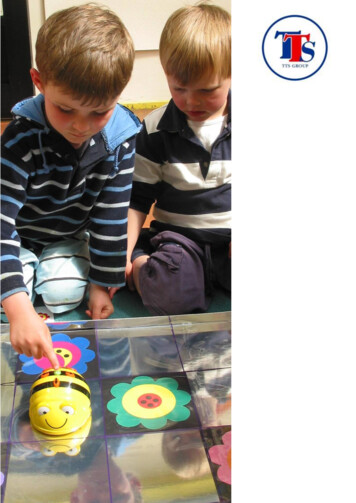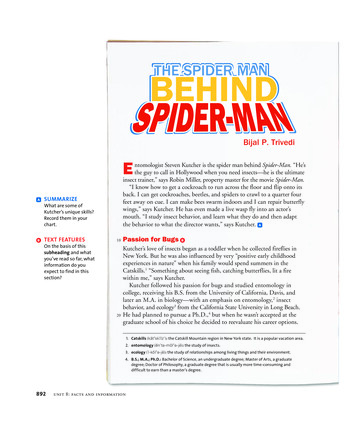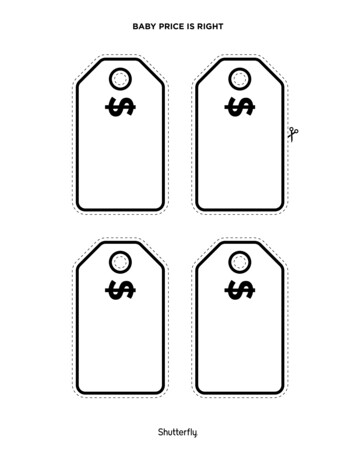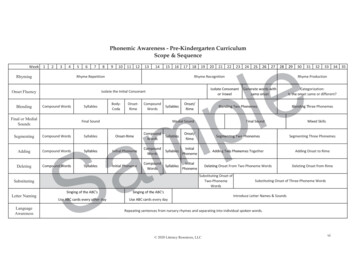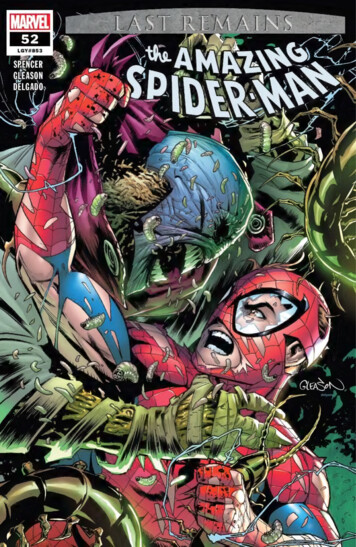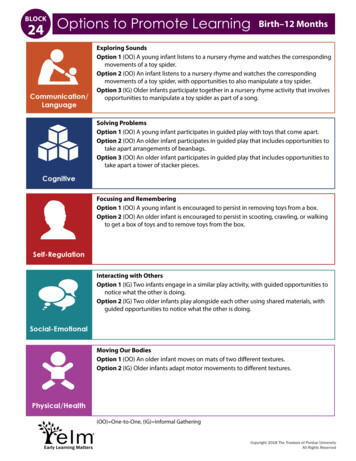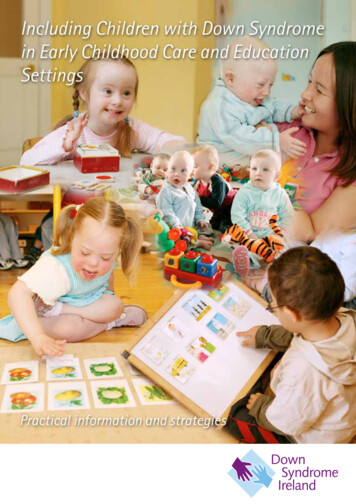
Transcription
alphabet songBaa Baa Black Sheep5 Little DucksHickory DickoryIf You’re HappyIncey Wincey SpiderOld McDonaldTwinkle TwinkleWheels on the BusBingoI’m a Little TeapotSing
ContentsForewordIntroductionIs Integration a Good Idea?Section 1) Overview of Down SyndromeSection 2) Strengths and Needs of the Child withDown SyndromeSection 3) Integrating the Child with Down Syndromeinto the Preschool EnvironmentSection 4) Communication with the HomeSection 5) Teaching the Child with Down SyndromeConclusionReferences & Useful ResourcesAcknowledgementsdown syndrome ireland Citylink Business Park, Old Naas Road, Dublin 12.t: 01 426 6500 low call: 1890 374 374 f: 01 426 6501 e: info@downsyndrome.ie w: www.downsyndrome.iecompany limited by guarantee. registered in dublin 131012 charity number 6062
ForewordIncluding Children with Down Syndrome in Early Childhood Care and EducationSettings is a very welcome and helpful support to all practitioners in the earlychildhood care and education sector. It promotes the right of all children to livein an inclusive society and points to the benefits we all stand to gain from suchinclusion.The significance of inclusion was emphasised in the IPPA submission to theEducation for Children with Disabilities Bill: “In early childhood, children are inthe process of meaning making; making sense of the world and their place withinit. Like all other children, children with a disability can only do this to the extentthat they are allowed to participate.” This booklet, too, is about actively helpingchildren participate and build positive identities for themselves and others in aninclusive community.The emphasis here is on the strengths and competencies of children with Downsyndrome and on building relationships with them. We are encouraged to “forma connection with the child and gently bring him or her into the group”, as we dofor all children.The special needs of children with Down syndrome are explained, along withguidelines on building their strengths and interests and supporting their copingstrategies. Every dimension of what constitutes good practice in the earlychildhood curriculum is described and, like the IPPA publication Power of Play,this booklet proposes that play is the most powerful tool for promoting learningand encouraging inclusion.This booklet advocates a holistic approach to learning, where teaching is a meansof building self-esteem and positive life images. This involves a commitment onthe part of the practitioner, who also has an additional incentive – as the authorsays: “The feeling of success is sweeter for the child, the parents, peers andteachers.”I look forward to seeing this booklet in every childcare service. I know that youwill find it extremely helpful.Carmel Brennan,IPPA, the Early Childhood Organisationdown syndrome ireland Citylink Business Park, Old Naas Road, Dublin 12.t: 01 426 6500 low call: 1890 374 374 f: 01 426 6501 e: info@downsyndrome.ie w: www.downsyndrome.iecompany limited by guarantee. registered in dublin 131012 charity number 6062
IntroductionEvery educator/carer wants to do their utmost tomeet the needs of children in their care during theearly childhood years – a crucial time in any child’slife. The information included in this publication hasbeen written to support you in your professional roleof facilitating the development of a young child withDown syndrome.Is Integration a Good Idea?This is a common question and deserves to beaddressed. Many parents are now choosing to“mainstream” their children because of growingresearch findings on the benefits of integration.We now know that the child with Down syndromecan gain significantly from the language and socialskills they observe in their typically-developing peers.They flourish with exposure to the rich language andplay experiences they witness around them. We alsoknow that the other children, too, benefit fromhaving a child with special needs as a peer.They develop their nurturing skills while learningnot to smother and, most importantly, they learnto accept differences by this early exposure. Fromthe caregiver’s perspective, children with Downsyndrome are usually not “difficult” and tend tobe popular members of their class.The unknown can be frightening. This is trueeven for parents when their baby is born, but theapprehension quickly dwindles once you get toknow the child and are armed with the appropriateinformation. This booklet has been designed to giveyou some basic information about Down syndromeand to offer you practical ideas for integratinga child with this syndrome into your group. Theinformation presented here is based on commontraits of children with Down syndrome, but of courseall children are different. As always, your bestresources are the parents of the child, the two whoknow their son/daughter best.down syndrome ireland Citylink Business Park, Old Naas Road, Dublin 12.t: 01 426 6500 low call: 1890 374 374 f: 01 426 6501 e: info@downsyndrome.ie w: www.downsyndrome.iecompany limited by guarantee. registered in dublin 131012 charity number 6062
Section 1Overview of Down SyndromeDown syndrome is a chromosomal disorder thata child is born with and has for life. The term‘syndrome’ indicates a set of recognisable clinicalfeatures which may be present at birth. Somechildren may have vision or hearing difficulties,motor impairments and medical conditions like aheart defect or bowel problems, but all of theseconditions are treatable. Some children will be morechallenged to learn, while others will appear to bemore like their typically-developing peers thanthey are different. People with Down syndromeoften have recognisable facial features whichhave nothing to do with their level of cognitivefunctioning. The most important thing tounderstand is that this is a child first - a childwho has the same needs as all other children.Early intervention is given for medical problems incombination with therapies - occupational therapy tohelp with strength, use of hands and independenceskills; physiotherapy to help with motor skills;and speech and language therapy to help withcommunication skills. As individual as children are,there are certain traits that tend to be evident inmost children with Down syndrome. The followingsection will detail the learning profile of a child withDown syndrome and Section 3 will offer some ideasfor integration, based on the learning profile, whichyou may find helpful.down syndrome ireland Citylink Business Park, Old Naas Road, Dublin 12.t: 01 426 6500 low call: 1890 374 374 f: 01 426 6501 e: info@downsyndrome.ie w: www.downsyndrome.iecompany limited by guarantee. registered in dublin 131012 charity number 6062
Section 2Strengths and Needs of the Child with Down SyndromeStrengths of the Child with DownsyndromeVisual learnerMost children with Down syndrome will learnbetter through demonstration rather than learningthrough mere verbal instruction. If informationis presented visually, together with verbal input,the child has a better chance of picking up theinformation and acting on it. For example, recentresearch indicates a growing interest in teachinglanguage through reading. Written words provide anadditional visual cue to what is normally a systemthat relies on auditory processing. Using signs alongwith the spoken word is also helpful to the child.Imitates wellThe child with Down syndrome is usually veryskilled in copying demonstrated actions. While thechild will copy many simple actions, s/he may needto be shown a complex action a few more timesthan typically-developing children. Once the actionis learned, the child will usually not forget theskill and will take great pride in the achievement.Unfortunately, children with Down syndrome alsoeasily pick up unhelpful behaviours by observationof adults and peers and these can, and should, becorrected.down syndrome ireland Citylink Business Park, Old Naas Road, Dublin 12.t: 01 426 6500 low call: 1890 374 374 f: 01 426 6501 e: info@downsyndrome.ie w: www.downsyndrome.iecompany limited by guarantee. registered in dublin 131012 charity number 6062
Responds well to praise andencouragementThe child with Down syndrome likes to be praisedand will work hard to please adults in the room.You can encourage positive behaviour by givingthe child your attention, letting him/her know whatbehaviours are acceptable. You do not have to say athing; your mere presence near the child is a rewardin itself. You make your attention more powerful bytalking to the child and giving eye contact. Like allchildren, but particularly for the child with a learningdisability, specific praise is the most effective. Insteadof saying “well done”, you say “good tidying up”or “good sitting still”. Specific praise ensures thatthe child knows exactly what you are pleased with,thereby increasing the chances that the behaviourwill be repeated.SociableChildren with Down syndrome like to be withother children and actively seek out their company.This makes integration into any group far easier andrewarding for all of the children.Can work well independentlyChildren with Down syndrome can be taughtto work independently if help is given only whenneeded and subsequently withdrawn. When the childhas acquired a skill, the child should be encouragedto perform it without assistance and then without anadult even nearby. In the initial stages, recognitioncan be given of independence (e.g. “Hey, you did thatall by yourself! Well done.”).down syndrome ireland Citylink Business Park, Old Naas Road, Dublin 12.t: 01 426 6500 low call: 1890 374 374 f: 01 426 6501 e: info@downsyndrome.ie w: www.downsyndrome.iecompany limited by guarantee. registered in dublin 131012 charity number 6062
Special Considerations for the Childwith Down SyndromeLanguage delayChildren with Down syndrome have difficultiesunderstanding and using language. These difficultiesvary greatly from child to child, but would be stronglyevident in most. This can lead to huge frustrationfor some children and may result in alternativebehaviours for communication, like throwing. Peopletend to understand more language than they use, soit is very possible that a child who uses no words mayunderstand much of what is said. Because of speechdifficulties, the child may have idiosyncratic words forobjects and actions or their speech may be difficult tounderstand. It is important that you be patient andallow the child time to talk. It is also helpful to useshort sentences and to break instructions down intosmall ‘chunks’. The child’s parents can explain howtheir child communicates and ‘what works’ for them.As always, the parents are an invaluable resourcebecause they know their child best. Some childrenwill also have the support of a speech and languagetherapist who you could call on for assistance.Social skills deficits(based on language delay)Children with Down syndrome are delayed in mostareas of development, including the acquisition ofsocial skills. A lot of social interaction is based in someway on language, yet while the child has a desire forinteraction, this is not enough. The children need tobe supported in how to ask for help, how to ask tojoin a play situation, how to wait until a peer has hadtheir turn and a multitude of other skills that formthe basis for friendships. Children who have siblingsclose in age tend to have developed more social skillsfrom the home environment. Like all children, thosewho do not have siblings may require more help inthis area.down syndrome ireland Citylink Business Park, Old Naas Road, Dublin 12.t: 01 426 6500 low call: 1890 374 374 f: 01 426 6501 e: info@downsyndrome.ie w: www.downsyndrome.iecompany limited by guarantee. registered in dublin 131012 charity number 6062
hearing days’. Research has indicated that roughlythree in four will have hearing loss sometime in theearly years. This means that a child with normallygood hearing might have a day or two - or evenlonger periods - where the hearing is significantlyaffected, usually when s/he has a cold or iscongested.Motor delaysChildren with Down syndrome have widespreadability in the area of motor development. It is notunheard of for a child to begin walking at age fouror first hold a pencil correctly well into the primaryschool years. Any motor delays will depend on othermedical conditions the child may have, in additionto the child’s level of muscle tone, ligament and jointflexibility and motivation. The child may also havedifficulty remembering a particular motor sequence,such as a dance, or have difficulty working out howto move to solve a problem, such as getting overan obstacle in an obstacle course. Fortunately, mostchildren overcome these difficulties in time andphysical ability does not necessarliy reflect cognitiveability. Therefore, a child should not be held backin the baby room, for example, simply becausethe child can not yet walk.The child may also have problems with the tactilesystem, which may be over- or under-sensitive.This will manifest in the child not wanting to touchcertain textures or not bothering to touch much atall. Brushing the hands with a specialist brushbefore eating or fine motor work can be very helpful(brushes available from Down Syndrome Ireland).The young child may also be frightened of certainmovements or sounds.Reduced immune defence systemPart of the syndrome may include having aweakened immune system. This means that somechildren with the syndrome may get many colds andblocked sinuses. It also means that the child mayhave numerous medical appointments, which willnecessitate missing days or hours of the day.Sensory impairmentsMany children with Down syndrome will havevision and hearing difficulties, not unlike theirtypically-developing peers. It is very common foryoung children with Down syndrome to have ‘baddown syndrome ireland Citylink Business Park, Old Naas Road, Dublin 12.t: 01 426 6500 low call: 1890 374 374 f: 01 426 6501 e: info@downsyndrome.ie w: www.downsyndrome.iecompany limited by guarantee. registered in dublin 131012 charity number 6062
Section 3Integrating the Child with Down Syndrome into the Preschool EnvironmentSuccessful integration begins with a basicunderstanding of the developmental status ofthe child with Down syndrome. Armed with thisknowledge, the adult is then able to adapt theenvironment to ensure maximum access to thecurriculum. This is true of all children; integrationshould not be viewed as ‘hard work’ or ‘difficult’anymore than it is when we introduce a newchild to our class. We form a connection with thechild and gently bring her/ him into the group.Whatever a child’s ability, being included inmainstream environments allows children to witnessappropriate models of behaviour and language, whilehelping the family to be more fully integrated intotheir community.The following is a collection of practical ideasfor supporting and integrating the child with Downsyndrome into a preschool environment. These ideasare based on extensive experience and research andcan support the positive experience we wish for allchildren.Promoting Integration1. Expect the child to behave in the sameway as the other childrenThis sounds obvious, but the reality is that weoften view children with Down syndrome as beingdifferent rather than being the same as their peers.Unconsciously, our expectations can come out inlittle behaviours telling the child and his peers thats/he is different. For example, when we hesitate toenforce the rules or allow the child to monopoliseour attention. The other end of the spectrum isbeing overly critical and perceiving behaviourswhich are developmentally age-appropriate (e.g.hair pulling) as being somehow different fromsame-aged children engaged in similar behaviour.The goal is for each child to follow the samebehavioural code as other children. Adult behavioursreinforce this goal when the expectation is clear fromthe very start. Incidents of so-called misbehaviourdown syndrome ireland Citylink Business Park, Old Naas Road, Dublin 12.t: 01 426 6500 low call: 1890 374 374 f: 01 426 6501 e: info@downsyndrome.ie w: www.downsyndrome.iecompany limited by guarantee. registered in dublin 131012 charity number 6062
in children with Down syndrome are often dueto some underlying cause, like communicationdifficulties, and not because of ‘naughtiness’.Viewing behaviour in this light will help you discoverthe cause of the misbehaviour and remedy thesituation, rather than blindly punishing.SUMMARY Expect age-appropriate behaviour Enforce rules in the same way2. Answer other children’s questionshonestlyYoung children are naturally full of questionsand wonder about the world we live in. To answera child’s questions as honestly as possible providesthem with the information they need to adapt totheir environment. If a child asks why a child withDown syndrome wears hearing aids or why she“keeps sticking out her tongue”, s/he is simply tryingto make sense of what s/he sees. When we givea factual, non-emotive account in clear language,the child simply accepts it (e.g. “The muscles inher mouth aren’t as strong as yours yet. In themeantime, we’ll just keep helping her remember toclose her mouth.”) It’s when we give vague answersin patronising tones that we create an air of mysteryand intrigue around the question and turn it into anissue.SUMMARY Answer questions honestly and factually Use a matter-of-fact tonedown syndrome ireland Citylink Business Park, Old Naas Road, Dublin 12.t: 01 426 6500 low call: 1890 374 374 f: 01 426 6501 e: info@downsyndrome.ie w: www.downsyndrome.iecompany limited by guarantee. registered in dublin 131012 charity number 6062
3. Ensure that the other children do not‘over assist’In every class above the baby room, there is atleast one child who assumes the role of ‘caretaker’or ‘special friend’ to the child with Down syndrome.This is usually a very healthy relationship and haspositive benefits for both children. Sometimes,however, the ‘special friend’ can assume far toomuch responsibility for the child with Downsyndrome, which is detrimental for both concerned.At times, the adult has to assert to the class that thechild with Down syndrome can take off her own coator retrieve her lunch box herself. Positive statementssuch as “Thank you, Mark, but Orla can do thatherself” can be a real confidence booster for Orla,and Mark will delight in her achievement.SUMMARY Stop peer over-assistance Actively promote and praise independence4. Adapt the environment as necessary topromote independence and successIn order to allow all children access to thecurriculum, whether that means reaching forplaydough on the table or a more formal education,we sometimes need to make small changes. Forexample, ensure that a child with hearing difficultiesis near you and has eye contact with you when youtalk, or move a child with locomotion difficultiesto different activities in the room. Less obviousexamples include giving the child ‘chunkier’ materialsto work with if she has fine motor difficulties. If achild is not succeeding in a task, look at how youcould adapt the materials to make it work. Maybe s/he could lace beads if the lace had a more defined tipand the beads were chunkier. Most children “can”they just need creative and observant teachers.SUMMARY Adapt the materials to suit the child Consider the layout of the room Make it easy for all children to workindependently5. Encourage interactions with peers anddown syndrome ireland Citylink Business Park, Old Naas Road, Dublin 12.t: 01 426 6500 low call: 1890 374 374 f: 01 426 6501 e: info@downsyndrome.ie w: www.downsyndrome.iecompany limited by guarantee. registered in dublin 131012 charity number 6062
friendshipsThis can be one of the hardest areas of integration,especially if the child has little language. Children withDown syndrome are usually sociable and interested intheir peers, but their language delay can really holdthem back. Around age four, the typical child’s playis heavily based in language and rules start to appearin some games. Friendships, too, are heavily steepedin language as children chat and giggle together. Thechild with language delays finds getting into andmaintaining this play difficult.In some cases, the child can adopt inappropriatebehaviours in order to communicate with others.Simply punishing these bad behaviours does notteach them what to do in those situations - and thechild can be left feeling bewildered or even morefrustrated. Instead, try and discover what s/he istrying to communicate or achieve when s/he engagesin bad behaviour. You can then facilitate appropriatesocial interaction by pre-empting bad behaviourand teaching the child how to initiate to peers. Forexample, you could teach the child how to gestureor say to others “sit here” or “can I play?” Little signsof friendship can open the doors to the social worldof peers.Who is my buddy today?Here we are.Some schools and preschools operate a “buddysystem”, whereby each child is paired with a buddyfor 10 to 15 minutes of free play time each day.During this time, the two buddies stay together,talk and play together. This expands the social andlanguage skills of all children in the class and ensuresthat no one is left out. The “buddies” are reassignedon a daily basis, so that over time each child will getto be a buddy with another child in the class.For more information on the buddy system, pleaseBuddy time.down syndrome ireland Citylink Business Park, Old Naas Road, Dublin 12.t: 01 426 6500 low call: 1890 374 374 f: 01 426 6501 e: info@downsyndrome.ie w: www.downsyndrome.iecompany limited by guarantee. registered in dublin 131012 charity number 6062
visit: www.downsyndrome.ieThe adult can also encourage socialisation byteaching the child with Down syndrome simpleplay routines adopted by children in the class. Forexample, if there is a home corner and children liketo ‘make dinner’, you could teach the child withDown syndrome how to put the pan on the cooker,turn it on and stir. This simple action ensures thatthe child is in the middle of the action and increasesthe chance of inclusion in the game. When s/he isproficient at cooking on the cooker, you could thenteach him/her to set the table, etc. If the child is stillon his/her own, the adult could then become involvedas a play partner or suggest to the other children “ohlook, Kieran is cooking vegetables for the meal”.SUMMARY Teach children how to initiate to theirpeers Teach children how to respond tocommon play situations6. Make language accessibleIt is important that the children are able tocommunicate with each other because languageplays such a significant role in social relationships.Young children with Down syndrome usuallyunderstand more language than they use, yet theymay often rely on signing to communicate, usingthe Lámh sign system (see Resources). Researchand experience has shown that once the childacquires the spoken word for an object, the childdrops the sign automatically. There is no evidenceat the present time to suggest that signing holdsdown syndrome ireland Citylink Business Park, Old Naas Road, Dublin 12.t: 01 426 6500 low call: 1890 374 374 f: 01 426 6501 e: info@downsyndrome.ie w: www.downsyndrome.iecompany limited by guarantee. registered in dublin 131012 charity number 6062
back a child’s speech development. At the sametime, signing has proven to significantly aidcommunication and language development.Young children actually enjoy signing, and thiscan increase their interaction because they areprogressively successful in communicating.Learning signing doesn’t need to be too taxingeither - the child’s parents could share signs withyou, or you could apply to do a course through thechild’s service provider or through the Lámh officedirectly.The development of a common language can alsobe fuelled through the use of objects and pictures,such as using pictures of different activities in theroom for the child to point to. An infant can point atobjects before s/he can sign or talk. Encourage theinfant to communicate by holding out two objectsand asking her/him to point to the one s/he wants.Of course, it is important to label the objects (byword and sign) so that s/he will learn the words.The child may benefit from having some pictures torepresent activities or objects. For example, you couldhave pictures to represent different songs to allowthe child to choose a song at circle time.Which song would you like?I’d like this one please.Please refer to the inside front and inside backcovers for a few basic song and activity pictures thatyou might find useful.SUMMARY Using signs is beneficial for increasingcommunication Pictures are also useful for extendingcommunication7. Children with Down syndrome respondbest to clear routinesImagine yourself arriving in a room where half ofthe language spoken is English and the other half is aforeign communication that you do not understand.Now imagine that you are asked (in this mixedlanguage) to perform certain activities, some ofwhich are new to you. The next day is the same, butin a slightly different order. It would probably makeyou feel unsettled and a bit anxious. This is how itcan feel for some children, particularly those with alearning and/or language difficulty.Having a clear routine for the order of the day andfor how activities are performed can help supportthese children. In addition to keeping to the dailydown syndrome ireland Citylink Business Park, Old Naas Road, Dublin 12.t: 01 426 6500 low call: 1890 374 374 f: 01 426 6501 e: info@downsyndrome.ie w: www.downsyndrome.iecompany limited by guarantee. registered in dublin 131012 charity number 6062
routine, you could display a picture schedule for theactivities of the day.What’s my job today?What’s happening next?You could also display picture strips demonstratingthe steps involved in every-day routines (e.g., apicture strip of washing and drying hands displayedabove the sink). These are best made by takingphotos of items in your environment, but there arecommercial pictures available (see resources section).These little reminders can help every child in theclass, not just the few who really need them.Oh, I’ve got to get the bags out.However, some children can find transitioningfrom one activity to another difficult even with thesesupports in place. If you find that this is the case,try giving the child a five-minute warning that anactivity will end. Some children also benefit fromhaving “to do” something during a transition time.For example, maybe you could ask the child to carrythe cups to the snack table or bring the bell in fromthe yard. Having a clear role focuses children.That’s it, I’m finished.down syndrome ireland Citylink Business Park, Old Naas Road, Dublin 12.t: 01 426 6500 low call: 1890 374 374 f: 01 426 6501 e: info@downsyndrome.ie w: www.downsyndrome.iecompany limited by guarantee. registered in dublin 131012 charity number 6062
SUMMARY Try to keep to a general routine ofevents Communicate your routine by a pictureschedule Give children a warning before the endof an event Some children need “to do” somethingduring transition times8. Step away when the child learns a taskGetting into the ‘habit of helping’ is a naturaloutcome of spending time with a child with alearning disability, who will often require moreassistance in learning tasks. To ensure that the childbecomes as independent as possible, it is importantthat adults in the room recognise when the child isable to perform a task on her/his own – the adultshould physically walk away from the child while s/he works at that task. Otherwise, we are teachingchildren that they can do nothing on their own.SUMMARY Only help when necessary Remove support as soon as possible Recognise and praise independencedown syndrome ireland Citylink Business Park, Old Naas Road, Dublin 12.t: 01 426 6500 low call: 1890 374 374 f: 01 426 6501 e: info@downsyndrome.ie w: www.downsyndrome.iecompany limited by guarantee. registered in dublin 131012 charity number 6062
Section 4Communication with the HomeShare songsChildren with Down syndrome, especially thosewith a hearing difficulty, need more repetition tolearn. A child who wants to join in with his/herpeers but is not sure what word or action comes nextcan become very frustrated – and can consequentlystop trying altogether. To make this easier for thechild, make sure you let the parents know when anew song is introduced so they can practice it withtheir child at home. It is also useful to occasionallysing slower than normal so that the child with Downsyndrome can sing along.Let parents know what is coming upIf you are starting a new topic, let the parentsknow before you introduce it to the class. If theparents have time to introduce the key words athome first, the child will have a better chance ofmaking sense of your teaching and will attend better.This is a strategy used widely in national schools andhas proven to work very well.Make sharing time more accessibleSome preschool groups have a short period in themorning where children are invited to share news.If so, tell the parents what you are doing and invitethem to draw or paste a picture on paper that thechild can show or use as a memory prompt fordiscussion.Use a communication bookNo one has time to write to parents abouteverything that happened in the day, but notingimportant information can be very helpful.Important information might include details onregular instructions the child is having difficultyfollowing (e.g. walking around mats on the floor).This lets the parents know how they can helpsuccessful integration by practising the task at home.Noting major achievements, particular interestsand special friends is also helpful; it can be verydemoralising if the only feedback parents everreceive is negative.down syndrome ireland Citylink Business Park, Old Naas Road, Dublin 12.t: 01 426 6500 low call: 1890 374 374 f: 01 426 6501 e: info@downsynd
down syndrome ireland Citylink Business Park, Old Naas Road, Dublin 12. t: 01 426 6500 low call: 1890 374 374 f: 01 426 6501 e: info@downsyndrome.ie w: www.downsyndrome.ie company limited by guarantee. registered in dublin 131012 charity number 6062 Section 2 Strengths and Needs of the Child with Down Syndrome
